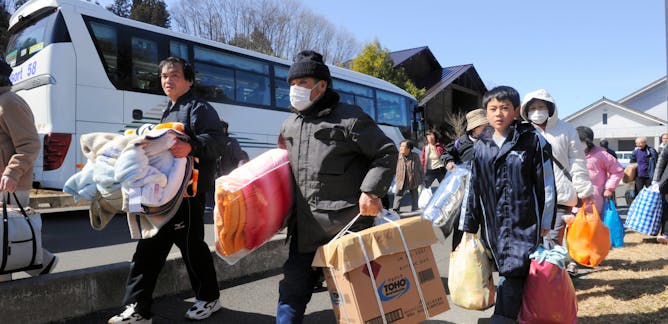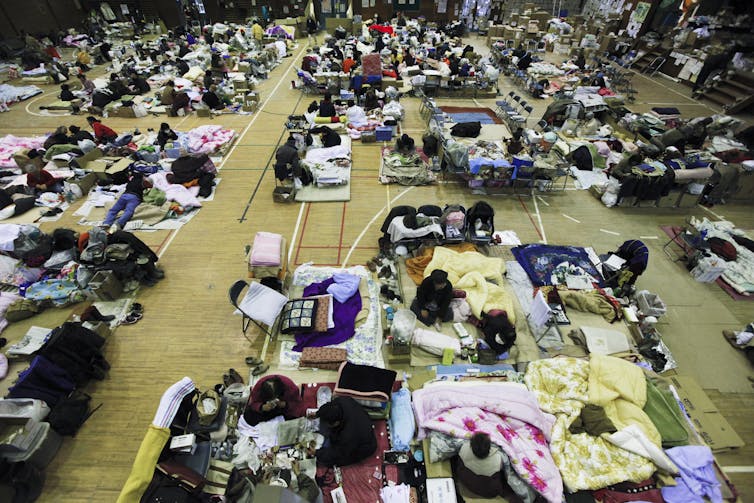 |
| Asahi Shimmbun/EPA |
More than 110,000 people were moved from their homes following the Fukushima nuclear disaster in Japan in March 2011. Another 50,000 left of their own will, and 85,000 had still not returned four-and-a-half years later.
While this might seem like an obvious way of keeping people safe, my colleagues and I have just completed research that shows this kind of mass evacuation is unnecessary, and can even do more harm than good. We calculated that the Fukushima evacuation extended the population’s average life expectancy by less than three months.
To do this, we had to estimate how such a nuclear meltdown could affect the average remaining life expectancy of a population from the date of the event. The radiation would cause some people to get cancer and so die younger than they otherwise would have (other health effects are very unlikely because the radiation exposure is so limited). This brings down the average life expectancy of the whole group.
But the average radiation cancer victim will still live into their 60s or 70s. The loss of life expectancy from a radiation cancer will always be less than from an immediately fatal accident such as a train or car crash. These victims have their lives cut short by an average of 40 years, double the 20 years that the average sufferer of cancer caused by radiation exposure. So if you could choose your way of dying from the two, radiation exposure and cancer would on average leave you with a much longer lifespan.
How do you know if evacuation is worthwhile?
To work out how much a specific nuclear accident will affect life expectancy, we can use something called the CLEARE (Change of life expectancy from averting a radiation exposure) Programme). This tells us how much a specific dose of radiation will shorten your remaining lifespan by on average.
Yet knowing how a nuclear meltdown will affect average life expectancy isn’t enough to work out whether it is worth evacuating people. You also need to measure it against the costs of the evacuation. To do this, we have developed a method known as the judgement or J-value. This can effectively tell us how much quality of life people are willing to sacrifice to increase their remaining life expectancy, and at what point they are no longer willing to pay.
You can work out the J-value for a specific country using a measure of the average amount of money people in that country have (GDP per head) and a measure of how averse to risk they are, based on data about their work-life balance. When you put this data through the J-value model, you can effectively find the maximum amount people will on average be willing to pay for longer life expectancy.
After applying the J-value to the Fukushima scenario, we found that the amount of life expectancy preserved by moving people away was too low to justify it. If no one had been evacuated, the local population’s average life expectancy would have fallen by less than three months. The J-value data tells us that three months isn’t enough of a gain for people to be willing to sacrifice the quality of life lost through paying their share of the cost of an evacuation, which can run into billions of dollars (although the bill would actually be settled by the power company or government).
 |
| Japanese evacuation centre. Dai Kurokawa/EPA |
The three month average loss suggests the number of people who will actually die from radiation-induced cancer is very small. Compare it to the average of 20 years lost when you look at all radiation cancer sufferers. In another comparison, the average inhabitant of London loses 4.5 months of life expectancy because of the city’s air pollution. Yet no one has suggested evacuating that city.
We also used the J-value to examine the decisions made after the world’s worst nuclear accident, which occurred 25 years before Fukushima at the Chernobyl nuclear power plant in Ukraine. In that case, 116,000 people were moved out in 1986, never to return, and a further 220,000 followed in 1990.
By calculating the J-value using data on people in Ukraine and Belarus in the late 1980s and early 1990s, we can work out the minimum amount of life expectancy people would have been willing to evacuate for. In this instance, people should only have been moved if their lifetime radiation exposure would have reduced their life expectancy by nine months or more.
This applied to just 31,000 people. If we took a more cautious approach and said that if one in 20 of a town’s inhabitants lost this much life expectancy, then the whole settlement should be moved, it would still only mean the evacuation of 72,500 people. The 220,000 people in the second relocation lost at most three months’ life expectancy and so none of them should have been moved. In total, only between 10% and 20% of the number relocated needed to move away.
To support our research, colleagues at the University of Manchester analysed hundreds of possible large nuclear reactor accidents across the world. They found relocation was not a sensible policy in any of the expected case scenarios they examined.
More harm than good
Some might argue that people have the right to be evacuated if their life expectancy is threatened at all. But overspending on extremely expensive evacuation can actually harm the people it is supposed to help. For example, the World Heath Organisation has documented the psychological damage done to the Chernobyl evacuees, including their conviction that they are doomed to die young.
From their perspective, this belief is entirely logical. Nuclear refugees can’t be expected to understand exactly how radiation works, but they know when huge amounts of money are being spent. These payments can come to be seen as compensation, suggesting the radiation must have left them in an awful state of health. Their governments have never lavished such amounts of money on them before, so they believe their situation must be dire.
![]() But the reality is that, in most cases, the risk from radiation exposure if they stay in their homes is minimal. It is important that the precedents of Chernobyl and Fukushima do not establish mass relocation as the prime policy choice in the future, because this will benefit nobody.
But the reality is that, in most cases, the risk from radiation exposure if they stay in their homes is minimal. It is important that the precedents of Chernobyl and Fukushima do not establish mass relocation as the prime policy choice in the future, because this will benefit nobody.
————————————-
This blog has been written by Cabot Institute member Philip Thomas, Professor of Risk Management, University of Bristol.
 |
| Professor Philip Thomas |
This article was originally published on The Conversation. Read the original article.





